Sensor based Gas Analyzer (CO, CO2 , NO , NO2, NOx, SO2, H2S, HC, O3, VOC) (ENVEA)
Cost-effective, ready-to-use miniature sensors for real-time monitoring of pollutants and odorous gases. Even at very low concentrations, Cairsens® micro-sensors from the Cairpol range allow continuous monitoring of diffuse emissions, whether in an industrial or urban environment. And their integration into our autonomous and communicating networks (Cairnet®) provides a new alternative to conventional stations for continuous air quality measurement.
APPLICATIONS:
- Odor monitoring
- Workplace Monitoring
- Indoor and outdoor air quality monitoring
- Mobile Hotspot Monitoring
- Leak detection
- Monitoring of fugitive emissions
Description:
Autonomous networks of sensor-based mini-stations (ENVEA)
A Cairnet® device is a real-time standalone and networkable air-monitoring station containing up to four Cairsens®microsensors and cellular communication within a waterproof enclosure. Compact, easily deployable and autonomous thanks to its solar panels, Cairnet® enables you to cost-effectively monitor dust and gas and gives a complete picture of the environmental impact of your operations. It offers unprecedented flexibility in producing accurate and dynamic air quality measurements across a broad swathe of industries and applications.
MAIN BENEFITS:
- Real-time monitoring and alerts of the most common types of pollutants: H2S/CH4S, NH3, nmVOC, O3/NO2, NO2, CO, SO2, PM10 & PM2.5
- Very high sensitivity to capture low level gas concentrations (down to ppb)
- Provides reliable measurement data at a fraction of the cost of reference method analyzers
- Evolutive, easy to use, easy to move: no cables or complicated installation, just set up and move to different locations on your site as needed
- Cairnet® requires only annual maintenance, when sensors should be replaced with new ones
- Ability to change the set of pollutants being monitored at any time (excepting dust)
- Embedded measurement of temperature, relative humidity and pressure
- Possibility to realize hybrid AQMS networks (reference stations & mini-stations)
- Measurements meet European directive 2008/50/EC
| CELLULAR COMMUNICATION CHARACTERISTICS:
· Technology and frequency bands: 2G/3G/LTE advanced Quad-band GSM/2G/ EDGE (850 MHz, 900 MHz, 1800 MHz, 1900 MHz) · Regulatory compliance: R&TTE directive 1999/5/EC Japan JRF/JPA – FCC – IC |
SITE CONFIGURATION AND COMMUNICATION MODE:
· 2,5G/3G cellular: suitable for large surface network deployments; area must be covered by the 2G to 3G network (data access contract required) · Radio Xbee: suitable for small sites. The distances between Cairnet stations and the central antenna (Modem / Coordinator) must not exceed 200 meters in free field. |


